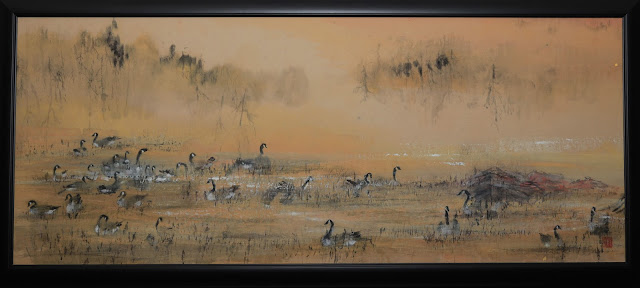I am an enthusiast of Chinese Brush Painting and I would like to share my trials and tribulations in learning the craft. I want to document the process, the inspiration and the weird ideas behind my projects and to address some of the nuances related to this dicipline. I hope to create a dialogue and stir up some interest in the art of painting with a Chinese brush on Xuan. In any case, it would be interesting to see my own evolution as time progresses.
Tuesday, November 3, 2020
Reflection completed
Thursday, October 1, 2020
Some of my framed pieces
I remember watching a clip of Joshua Bell performing incognito at the subways platform in New York and with a few exceptions most of the bridge-and-tunnel bipedals didn't even break their strides, barely casting a second glance.
One might argue that most of these folks might not be Lincoln Center patrons, and Sibelius might be just as foreign to them as Chi Baishi, but if the subway was to be transformed into Lincoln Center and people had to pay good money to watch him play, would we have witnessed a different outcome?
I suppose the reason that I dressed up some of my paintings with a frame is my way of validating my works, or satisfying my own narcissistic urges. I mean, even getting a haircut during the Covid shutdown is such a big deal, so how about making some of my paintings more presentable, albeit not a haircut, for no excuses other than for my own consumption? They are hanging on my walls nonetheless. Museum pieces they are not, providing enjoyment they do. They are like our children, and all our children are gems, right?
Saturday, September 19, 2020
Reflection
The year of the Rat certainly is a strange one to say the least. I honestly thought I was going to push at least a couple more pins to my world atlas on the cork board to remind myself where I had been, in case my gray matter continues to shrink. I almost bought my fares for travelling, fortunately procrastination saved my bacon.
Obviously I have ample opportunity to reflect on places where I had left my footprints; especially poignant when I am not allowed to venture too far these days due to the pandemic. I don't want to be embroiled in today's issues but being a septuagenarian I can't help but reflect on my experiences here and abroad, both good and bad; privileged and not so privileged. I recall the early days of becoming a pharmacist, as a member of the most trustworthy profession who happens to be of a minority race here. Oh, so dichotomous! I remember asking my colleagues what gook meant, since some of the people I served addressed me by that name and I've not had the good fortune of learning that word when I was studying English in Hong Kong.
What I was reflecting on these past few weeks was actually something more tranquil, a waterfowl refuge. I used to frequent this sanctuary quite often before I hung up my white smock for good since it was not too far from my place of employment. I used to go there to relax and forget about filling prescriptions.
I shall attempt to put my thoughts on Xuan.
I wanted to portray a levy in this refuge, and the reflection of this levy in the water of course. I wrestled with myself a little bit as where to locate the levy. Ideally it would be right smack in the middle of the paper so I could devote the same amount of attention to the reflection in the water, but I remembered being told that this would be bad composition. I decided on a compromise; levy bisecting the paper, but with a little footbridge access on one side to break the line up.
I folded my un-sized Xuan into halves, and I would paint my levy on the crease line.
The color looks more saturated when wet but dries to a much lighter value. This is especially true when painting with Xuan.
Tuesday, August 25, 2020
My Third Refrain on Yang Pass 西出陽關無故人
Having laid the groundwork for my painting in ink, I began the coloring process. I chose the semi-sized Xuan because I wanted the color to float. I had a sandstorm in mind. The semi-sized paper also tend to mute the color a bit, rendering a natural haze to the painting.
I got the right hue for the sky by mixing ink and indigo, leaving places uncovered to reveal clouds.
A much more intense perspective of inside versus outside was achieved. Now the diminutive desert seemed less like an insert and more convincing as the view outside the sentry window.
Tidied up little details here and there, still not satisfied with my camel. Then it dawned on me that my idea of the traveler walking with his camel was certainly endearing, or even altruistic in a sense, but the practicality of the camel as a freight hauling vehicle certainly could not be discounted.
Thus I added some provisions onto the sides of the camel. Now a bactrian camel laden with freight being led by a traveler with walking stick is a more plausible story line. Together they would brave the distance and any calamity that might come their way. I mean if I was a producer making a movie about the Song of the City of Wei, this would be the last footage the audience would see as the credits are being superimposed on the silver screen; and the house lights slowly coming back on.
Since I made reference to the refrains of the Yang Pass Song, the Three refrains on the Yang Pass Theme, which by the way is a famous Guqin piece, I would like to present my three refrains from a visual standpoint:
Safe traveling my friend!




















































